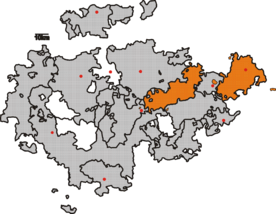Free State of Saxony-Altenburg
| coat of arms | flag |
|---|---|
| The previous small coat of arms of Saxony-Altenburg (the so-called Saxon rhombus coat of arms) | White-Green (Article 1 of the Act on the Provisional Regulation of the Constitution of March 27, 1919)
|
| Situation in the German Reich | |

|
|
| Arose from | Principality of Saxony-Altenburg |
| Incorporated into | State of Thuringia |
| Data from 1919 | |
| State capital | Altenburg |
| Form of government | republic |
| Consist | 1918-1920 |
| surface | 1,323 km² |
| Residents | 209,904 inhabitants |
| Population density | 159 people / km² |
| Religions | 96.2% Ev. 3.4% Roman Catholic 0.5% others |
| Reichsrat | 1 vote |
| License Plate | SA |
| administration | 1 city district and 3 administrative districts |
| map | |

|
|
The Free State of Saxony-Altenburg was a free state in (today's) eastern Thuringia , which existed from 1918, the abdication of the Duke of Saxony-Altenburg, until 1920, when the State of Thuringia was founded. In terms of its layout, it was identical to the Duchy of Saxony-Altenburg .
history
After Duke Ernst II abdicated on November 13, 1918, the Free State of Saxony-Altenburg was founded. The residential city of Altenburg then became the state capital of the new Free State. Wilhelm Tell became the leading minister of state of the transitional government . After the state elections, which took place on January 26, 1919, the parties SPD and DDP formed the new government. With the exception of Wilhelm Tell, it was composed of the transitional government. The new Minister of State was August Frölich (SPD). The Landtag of the Free State of Saxony-Altenburg passed a law on March 27, 1919 for the provisional regulation of the constitution.
On May 1, 1920, the Free State was opened in the state of Thuringia . Until April 1, 1923, it retained the status of a higher-order local authority association with its own regional government and regional representation as the "Altenburg area" . In addition, in the first 15 years after the Thuringian state constitution of 1921 came into force, a member of the state government always had to come from the Altenburg area.
Cities
| city | Population (1919) |
|---|---|
| Altenburg | 37,289 |
| Schmoelln | 10,924 |
| Eisenberg | 10,030 |
| Meuselwitz | 9,171 |
Administrative division
The Free State of Saxony-Altenburg consisted of the independent city of Altenburg and the three district offices of Altenburg , Roda and Ronneburg .
Election to the first state parliament
On January 26, 1919, the election for the first state parliament took place.
| Election to the 1st state parliament in 1919 | |||
|---|---|---|---|
| Political party | Voting share in% | Seats | |
| SPD | 58.55% | 24 seats | |
| DDP | 24.64% | 10 seats | |
| DNVP | 16.82% | 6 seats | |
100% missing votes = not represented in the state parliament
Individual evidence
- ↑ Joachim Emig: State Assembly of the Free State of Saxony-Altenburg and Area Representation Altenburg 1919–1923. In: Thüringer Landtag, Harald Mitteldorf (Ed.): The forgotten parliaments. State parliaments and regional representations in the Thuringian states and regions 1919 to 1923. Hain, Rudolstadt 2002, pp. 161–182.
- ^ Bernhard Post, Volker Wahl: Thuringia Handbook. Territory, constitution, parliament, government and administration in Thuringia 1920 to 1995. Böhlau, Weimar 1999, p. 326.